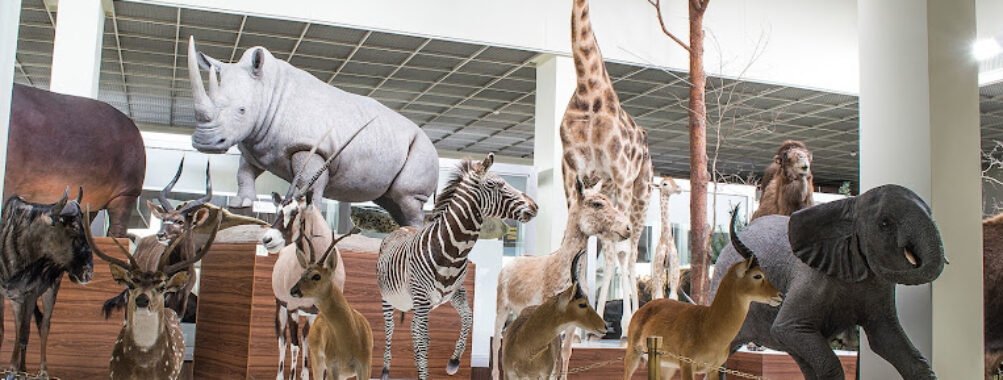
Kaunas Tadas Ivanauskas Museum of Zoology
Table of Contents
Description
The Kaunas Tadas Ivanauskas Museum of Zoology is a quietly proud institution in Kaunas that has been collecting, classifying and displaying the natural world since 1919. Named for Tadas Ivanauskas, a pioneering Lithuanian zoologist, the museum focuses on zoology with a traditional, somewhat old-school approach: taxidermy, skeletons, insects and richly detailed dioramas. For travelers who like museums that feel like a cabinet of curiosities rather than a slick, modern visitor center, this place is a genuine treat.
Visitors step into exhibits that mix century-old specimens with later additions from scientific research and university collections. The displays show birds, mammals and insects alongside skeletal mounts that reveal how animals are built. There is a strong educational bent here — placards explain not just what species are on view, but why they matter to Lithuania and the wider region. And yes, the dioramas have that kept-alive-in-a-box charm: a little theatrical, a little dusty, utterly evocative.
Practical things first: the museum is easy to reach if one is spending time in Kaunas city, and it often becomes a favorite for families visiting on a rainy day or for anyone curious about natural history without the pretense of a fancy modern overhaul. It is especially good for kids — interactive moments and clear specimen groupings help younger visitors understand biodiversity, food chains and skeletal anatomy. Many parents report that kids come away with new questions, and that’s always a win.
But the experience is not purely for children. Naturalists, students and travelers who enjoy a slow, focused museum visit will appreciate the breadth of the collection. There are insects carefully pinned and labeled, local and international birds preserved to show plumage and size, and a selection of mammals whose skeletons are displayed with the sort of clinical curiosity that researchers value. The museum also serves as a small research hub, connected historically to university work and regional study of species and conservation.
Something worth mentioning — and this is the kind of detail that separates first-time visitors from those who return — is the atmosphere. The lighting and layout lean toward the scholarly rather than the theatrical. Some exhibits look like they could tell stories if they could talk. If a traveler is expecting flashy interactive screens and immersive VR, they might be surprised. If a traveler is fine with careful labels, intact specimens and a sense of continuity from the early 20th century to present-day science, they will likely leave impressed.
The museum is mindful of accessibility: there is a wheelchair accessible entrance, parking and restroom facilities. Not every small museum takes such practicalities seriously, so this is reassuring for visitors with mobility needs. However, visitors should note that there is no on-site restaurant; bring a snack or plan a coffee stop nearby after the visit.
One of the less obvious strengths is its local focus. The collection highlights Lithuanian fauna alongside species from farther afield, making it a good primer on regional biodiversity and conservation concerns. The exhibition texts often connect specimens to habitat loss, migration patterns and research efforts — so it manages to be both historical and quietly topical.
The writer remembers bringing a small, skeptical nephew who wandered in disinterested and emerged wanting to draw birds for a week. The author also remembers a late-afternoon visit when the quiet rooms and rows of specimens made walking through feel like leafing through an old naturalist’s field journal. Those little personal flashpoints are why travelers sometimes prefer a museum like this over bigger tourist draws: it’s intimate, it rewards patience, and it invites curiosity.
For photographers, the museum offers texture and detail rather than dramatic color. Macro shots of pinned insects, close-ups of feather structure and the shadow-play over bone displays are rewarding. But be mindful: the lighting is conservative to protect specimens, so no flash photography unless permitted.
Finally, the Kaunas Tadas Ivanauskas Museum of Zoology has that rare mix of science and nostalgia. It speaks to the history of zoological study in Lithuania while still serving an educational mission for present-day visitors. Travelers who are planning their Kaunas itinerary should consider a relaxed hour or two here — longer if they really like taxidermy and natural history — and expect to come away with a clearer sense of the natural world that surrounds this part of Europe. It’s not flashy. It is honest, informative and surprisingly coaxing of wonder.
Location
Places to Stay Near Kaunas Tadas Ivanauskas Museum of Zoology
Find and Book a Tour
Explore More Travel Guides
No reviews found! Be the first to review!